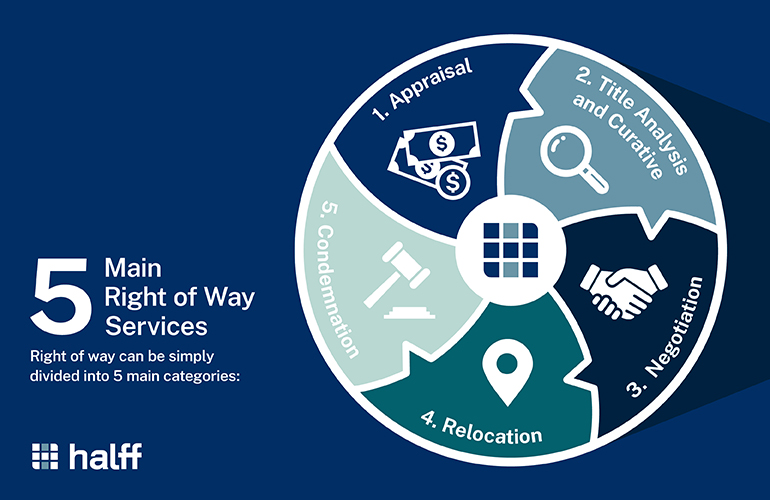5 Main Right of Way Services You Must Know
Right of way is defined as the right to pass across the land of another.
This may be applied to roads, railroads, pipelines, utility lines and drainage, among other things. There are many different services that go into right of way projects.
While right of way can be a complex topic to grasp, it can be more simply divided into five main categories:
- 1. Appraisals
- 2. Title Analysis and Curative
- 3. Negotiation
- 4. Relocation
- 5. Condemnation
1. Appraisals
Right of way appraisals are used to determine the fair market value of the property being acquired. They are typically prepared by independent third parties.
The valuation process is the model appraisers use to develop a value opinion. This process consists of:
-
-
- appraisal problem definition
- scope of work
- data collection and analysis
- land value opinion
- the three approaches to value (cost approach, Income Capitalization Approach and Sales Comparison Approach)
- reconciliation and final value opinion
- appraisal report
-
The appraisal report is generally written and must explicitly set forth the appraisal in a manner that isn’t misleading. It contains sufficient information that allows the users to understand the report properly. It must clearly and accurately disclose any extraordinary assumptions, hypotheticals or limiting conditions that directly affect the appraisal.
The value: Appraisals are essential to ascertain fair market value. They go through a diligent and comprehensive valuation process consistent with the Appraisal Institute guidelines.
2. Title Analysis and Curative
When acquiring property in fee simple interest, generally the property must be acquired free and clear of all liens, encumbrances, etc. that may “cloud” the title. Partial and/or full releases of liens, easements, tax suits, etc. must be obtained prior to the completion of the acquisition process.
This may be accomplished by first obtaining permission from the landowner to speak to their lender concerning the liens. An Owner’s Authorization is typically signed by the landowner granting that permission. The lender is then contacted once permission is obtained, and the acquisition and required curative action is discussed.
Many times, the lenders ask to review the appraisal. This helps them determine if any of the compensation paid to the owners may be required by the lender as a paydown to the loan in exchange for the executed partial release of the lien being sought. A full release is sometimes needed, which would mean that the lender requires all compensation up to the total amount of the lien.
Partial releases of easements are a bit more labor intensive. All parties to the easement must agree that the easement can be partially/fully released, and all parties must execute the release document. Compensation may be required by the easement holder, depending on the type of easement.
The value: Title Curative resolves liens and encumbrances on a property, ensuring clear ownership before acquisition.
3. Negotiation
Negotiation is the primary method used to acquire property interests, whether that be fee simple or easements. Successful negotiations are determined by two factors:
-
-
- issues must be negotiable
- participants must be both willing and able to negotiate
-
It begins by determining fair market value, which is done through the appraisal process. Once the initial compensation has been determined and approved, a negotiator will work with the landowner and/or their representative to review the compensation offered and determine the best course of action.
The landowner has the option to either accept or decline the offer. If the landowners decline the offer, that does not mean that their property will not be purchased. However, it allows the owner to submit a counteroffer as an amount that they feel is fair compensation. That amount gets reviewed by the acquiring agency, and if it is determined to be fair and justified, the landowner will receive the increase. If the agency determines that the counteroffer amount is not fair or cannot be justified, then the property may be acquired through condemnation process.
The value: Negotiation is a formal discussion between people who are trying to reach an agreement, as defined by Oxford dictionaries. It serves as the primary means to successfully acquire property interests, if issues are negotiable and the participants are willing.
4. Relocation
Relocation is simply when organizations, businesses, residences and personal property are displaced from the property as a result of federal, state or local agency right of way projects.
It is imperative that the right of way provider is not only experienced in providing relocation services under the agency’s policies and procedures—the Federal Uniform Relocation Assistance and Real Property Acquisition Policies Act of 1970 (URA)—but also those required by Senate Bill 18 and the Texas Property Code.
A displaced person or entity who is required to relocate from real property, or has personal property affected as a direct result of the acquisition process, may be entitled to certain relocation benefits. These benefits are different, depending on the type of displacement (residential vs. commercial vs. personal property). These benefits are discussed with the displaced person(s) or entity as part of the relocation advisory services. Relocation advisory services are offered throughout the move and reimbursement claiming processes.
The value: Relocation advisory services are crucial for displaced entities to properly identify and process the relocation benefits.
5. Condemnation
You may hear the terms eminent domain and condemnation used interchangeably; however, eminent domain is the power of a governmental body to take private property for public use when a public necessity exists. Condemnation is the legal process by which the agencies exercise this power.
Condemnation is the act or process by which property is acquired for public purposes under the power of eminent domain. Following due process of law, the condemnation process and on the payment of the award or just compensation, the agency may obtain possession.
Just compensation is typically determined in Texas by three court-appointed special commissioners during a Special Commissioners Hearing. Court-appointed commissioners are landowners in the county in which the acquisition of land is taking place. The commissioners, landowner, agency, legal representatives, appraisers, technical experts and other interested parties convene in a location previously determined. The witnesses provide testimony and justification/support regarding fair market value. The special commissioners serve as the triers of fact tasked with determining the compensation that will be paid to the landowner for the property interest being acquired.
In Texas, if either party disagrees with the award of the special commissioners, the disagreeing party may object and pursue the fair market value determination via a trial by jury.
The value: Condemnation is the legal process of acquiring property for public use under eminent domain, and determines fair and just compensation through a court hearing.
Summary
These five main right of way services each play essential roles in the property acquisition and relocation processes.
Appraisals identify just compensation, and property valuation (title) curative resolves liens and encumbrances to provide superior title ownership for the acquiring agencies.
Negotiation works the process between the agencies and the landowners, while relocation provides advisory services for displaced entities.
Condemnation supports the acquisition process when the landowners and agencies are unable to agree on fair market values, or when title curative processes may not adequately address title encumbrances.
Need a right of way expert? Contact Halff’s team of experienced and trusted professionals to get started. Reach out to Right of Way Practice Leader Mark Janicki (mJanicki@halff.com), or visit our Right of Way service page to view Halff’s projects and offerings.







